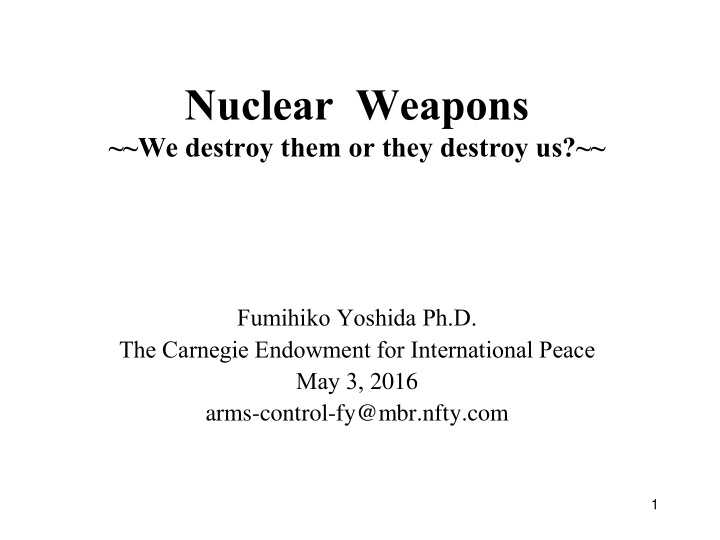



Nuclear Weapons ~~We destroy them or they destroy us?~~ Fumihiko Yoshida Ph.D. The Carnegie Endowment for International Peace May 3, 2016 arms-control-fy@mbr.nfty.com 1
Before and After (Hiroshima) 2
Casualties (1) On August 6, 1945, a US bomber dropped an atomic on Hiroshima. Around 140,000 people died until the end of 1945. (2) On August 9, 1945, a second atomic bomb was dropped on Nagasaki. Estimates generally put the number of deaths around 80,000 until the end of 1945. (3) It is estimated that out of every 6 deaths in the bombings, 5 were civilians and 1 was military. (More than 80% were civilians) (http://www.domlife.org/Justice/Disarmament/bombfactsheet.pdf) 3
Were there more casualties than those who died when the bomb hit? (1) Yes. (2) Many more people suffered for several or many years before dying due to radiation exposure from the bombs. (3) It is estimated that by 1950, 200,000 more people had died from atomic bomb-related diseases or injuries. (4) Many more lived with permanent suffering. (http://www.domlife.org/Justice/Disarmament/bombfactsheet.pdf) 4
What types of long-term effects due to radiation? (1)Cancer was the most common radiation-caused disease. (2)Other diseases, such as liver failure and respiratory diseases, occurred in atomic bomb-survivors. (http://www.domlife.org/Justice/Disarmament/bombfactsheet.pdf) (3)The average age of the survivors has now reached 80.13 as of the end of March 2015. (4)This marked the first time that the average age of A- bomb survivors has exceeded 80. (http://www.hiroshimapeacemedia.jp/?p=46730) 5
Nuclear Arsenal : During and After Cold Warhttp://www.armscontrol.org/files/images/US_Stockpile_A.png 6
Nuclear Weapons Today http://fas.org/issues/nuclear-weapons/status-world-nuclear-forces/ 7
In case Vancouver is …… See the immense area destroyed by a nuclear firestorm created by the explosion of one nuclear weapon. (Computer Simulation) http://www.nucleardarkness.org/nuclear/nuclearexplosion simulator/ 8
JFK Address Before the General Assembly of the United Nations, New York City, September 25, 1961) (1)Today, every inhabitant of this planet must contemplate the day when this planet may no longer be habitable. (2) Every man, woman and child lives under a nuclear sword of Damocles, hanging by the slenderest of threads, capable of being cut at any moment by accident or miscalculation or by madness. (3) The weapons of war must be abolished before they abolish us. 9
What happened at Fukushima (1) Accident of multiple reactors – meltdown of nuclear fuel at reactor Unit 1, 2 and 3 – spent fuel pools damage in Unit 4 (2) Evacuees – Fukushima prefecture: 2 million – At least 160,000 people has been evacuated their original home because of fear of radiation as of October, 2012. – 56,920 people have fled their home in Fukushima pref. and stay in other prefecture as of March , 2013. 10
Evacuees from Fukushima to Other Prefectures (as of July 2012 – November 2013) http://fukushimaontheglobe.com/the-earthquake-and-the-nuclear-accident/situation-of-the-evacuees 11
Weaponization of Nuclear Facilities (1) An attack on nuclear facilities by terrorists or during war can cause a serious radioactive emergency. (2) An attack with conventional weapons leading to the release of radioactivity would produce some of the effects of nuclear weapons. (3) Because of the possible magnitude of radioactive contamination in such an attack, we should regard nuclear facilities as potential enemy weapons that are beyond our control. 12
How we can change? ( 1)A book edited by Bernard Brodie in 1946 said that “(i)t is not only sovereign states but individual attitudes which must undergo transformation” in the nuclear age. (2) As individuals, “citizen empowerment” does matter a lot. (3) Shall nuclear weapons, including weaponized nuclear facilities, destroy us or shall we destroy them? 13
Conclusion The answer depends on us, not them. Thank you very much for your attention. 14
Recommend
More recommend